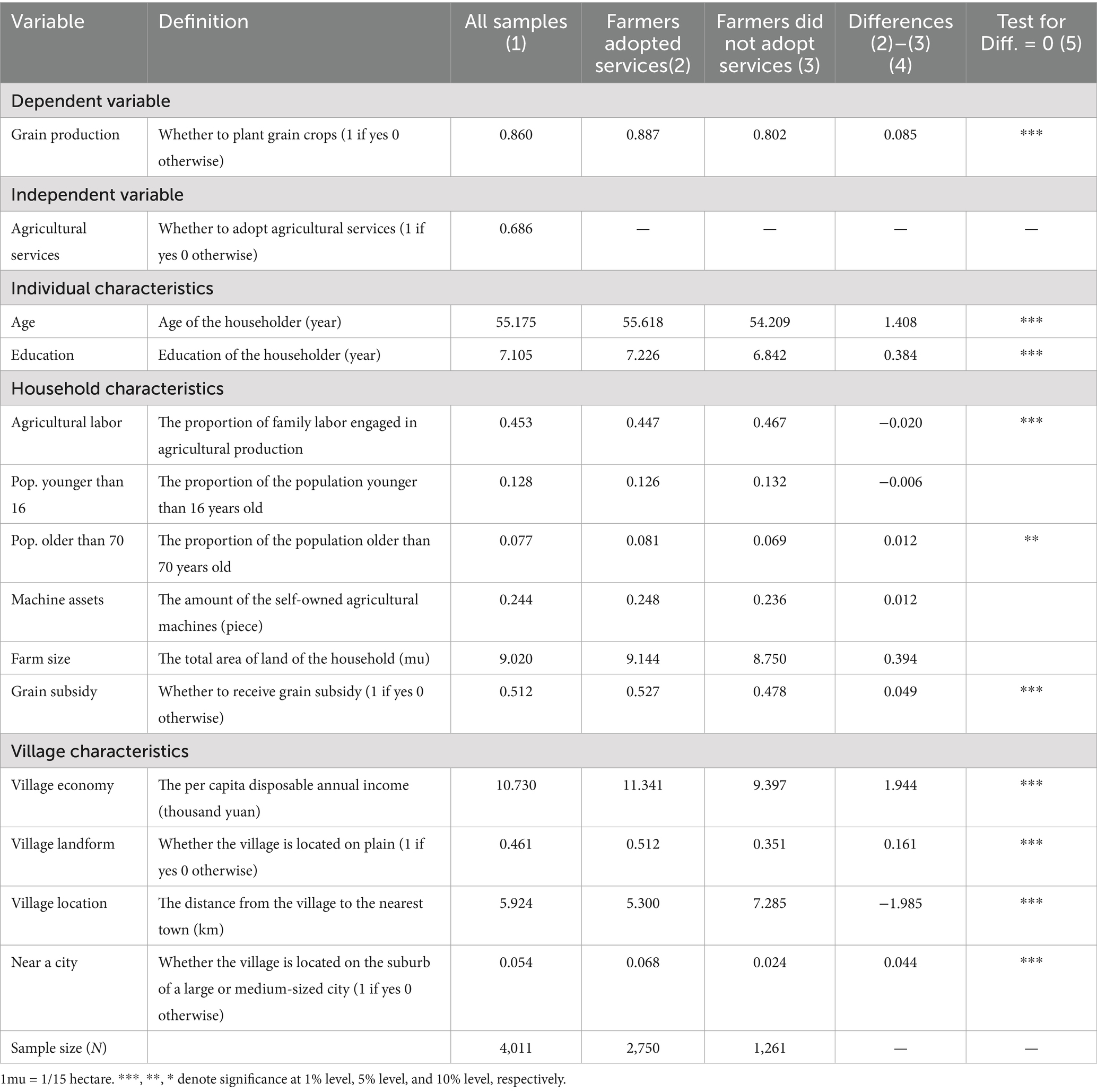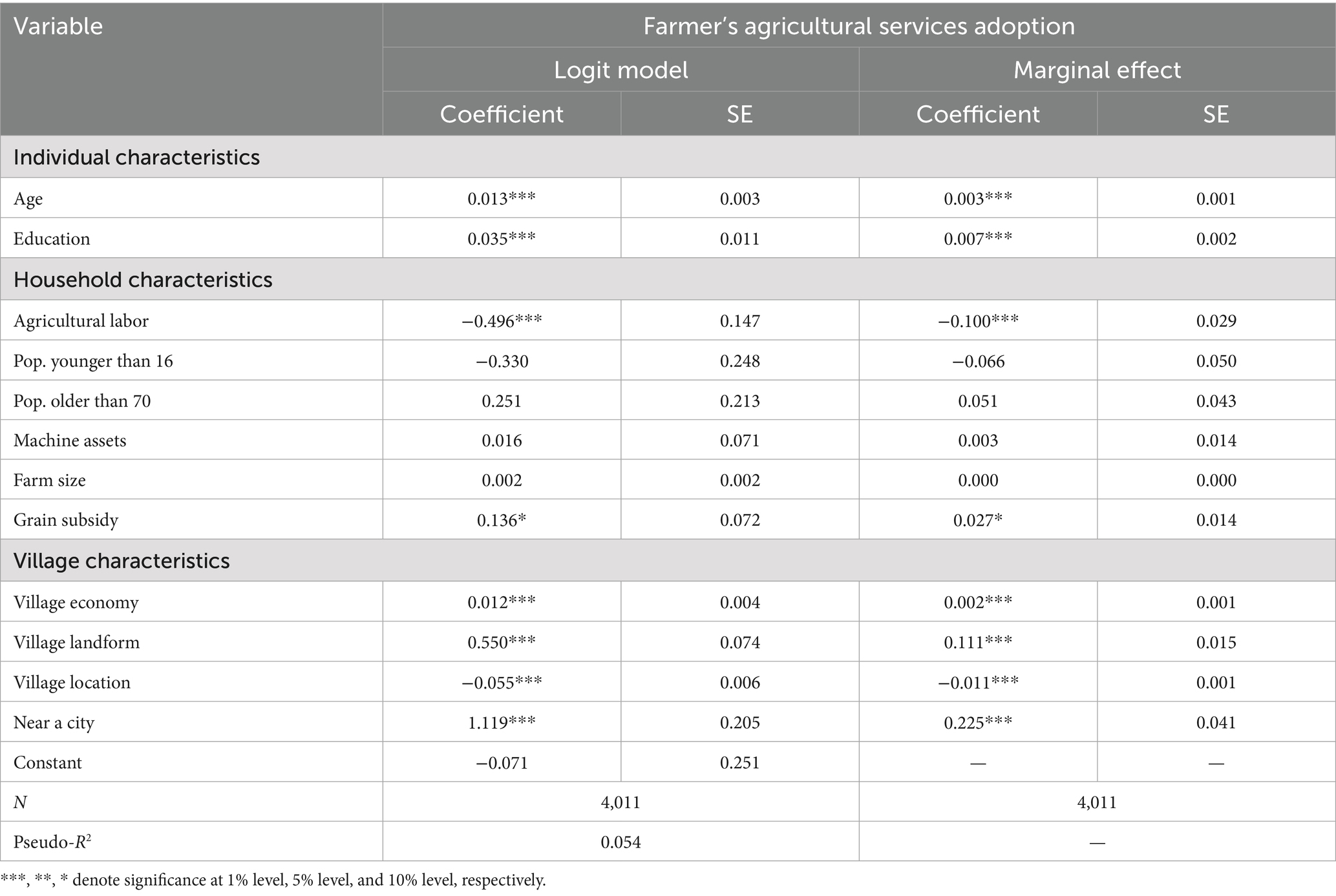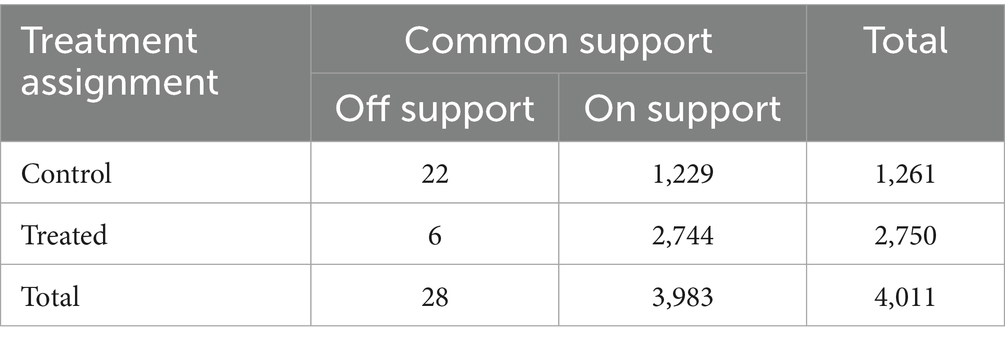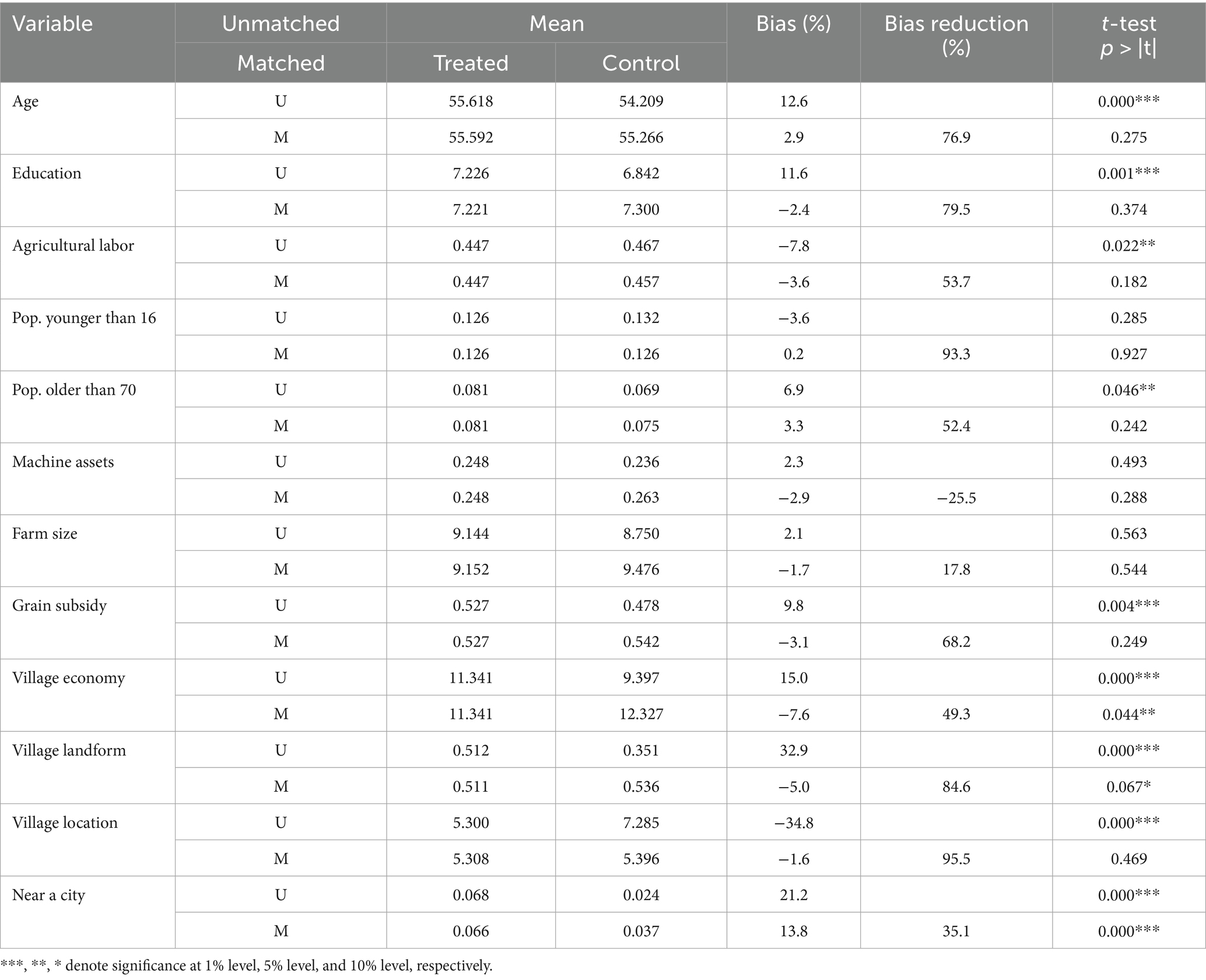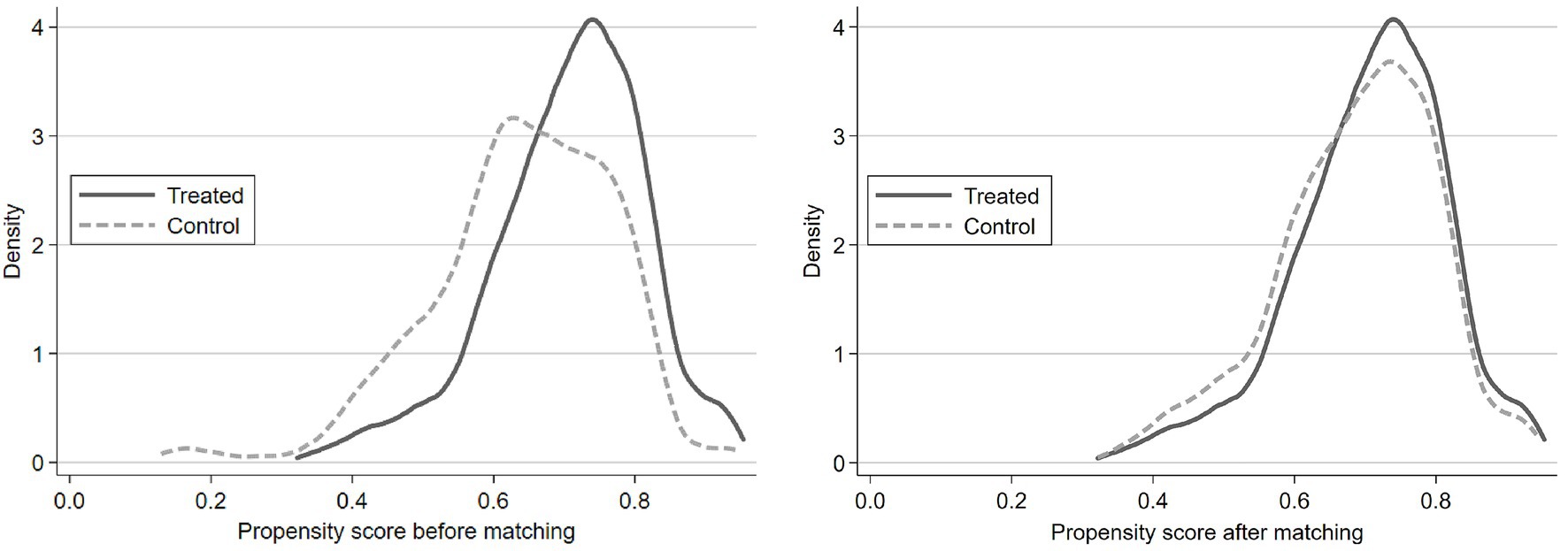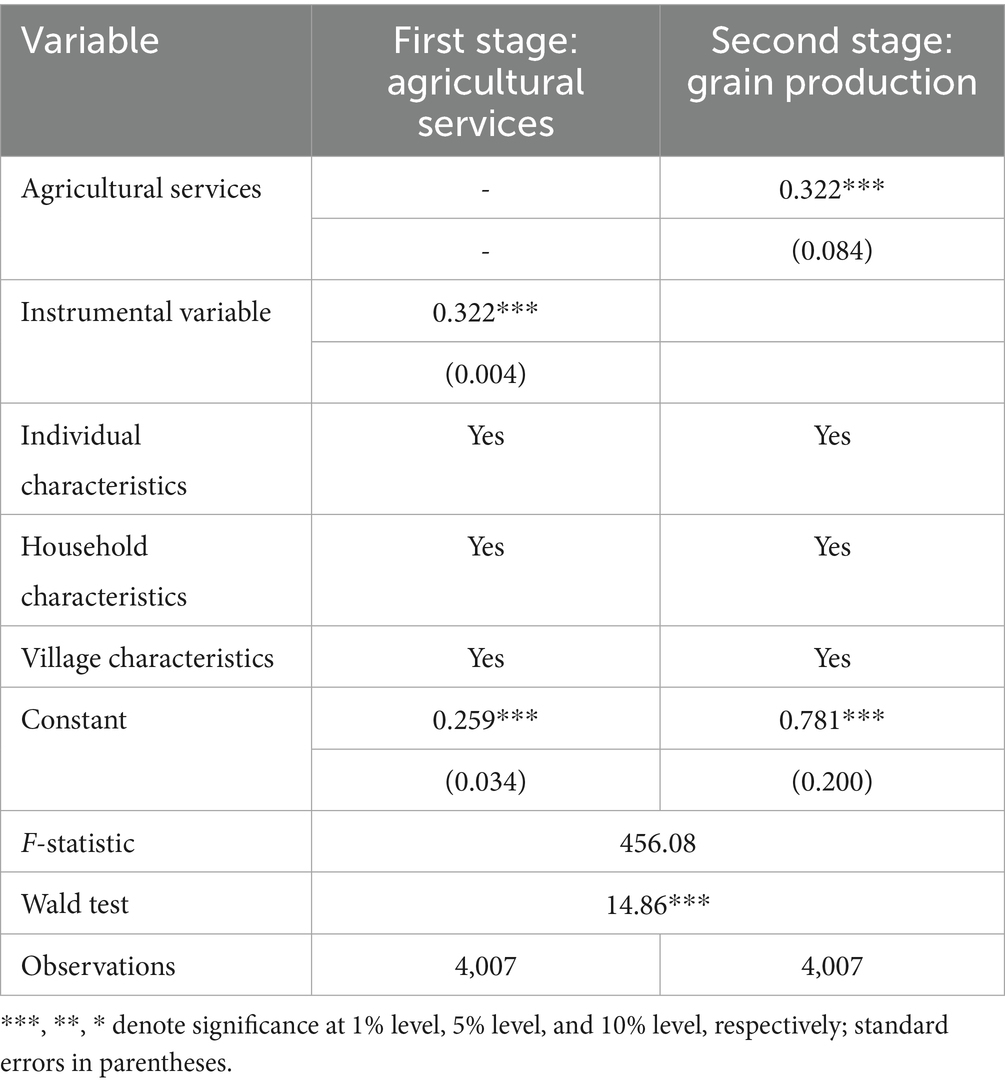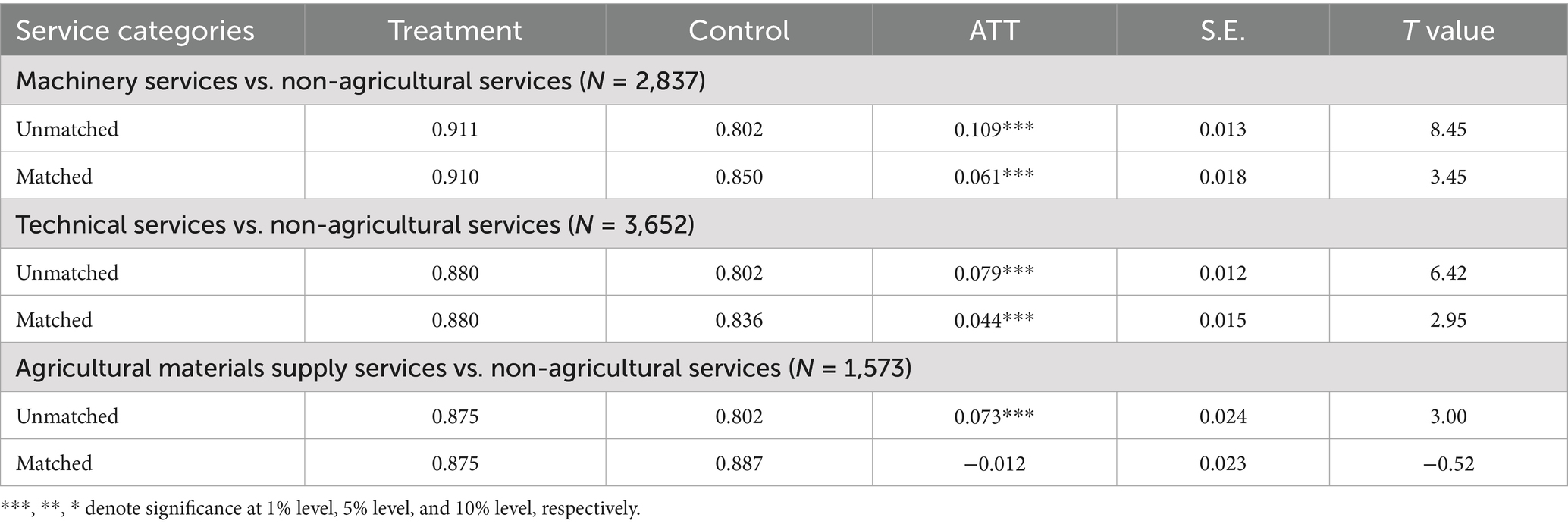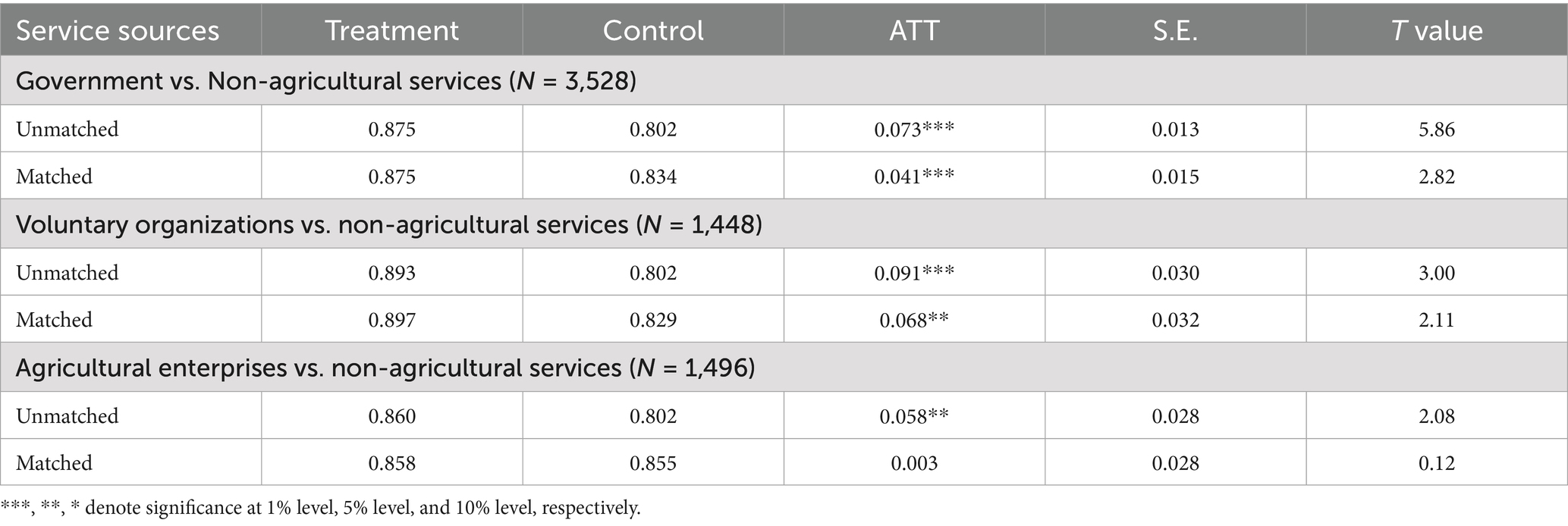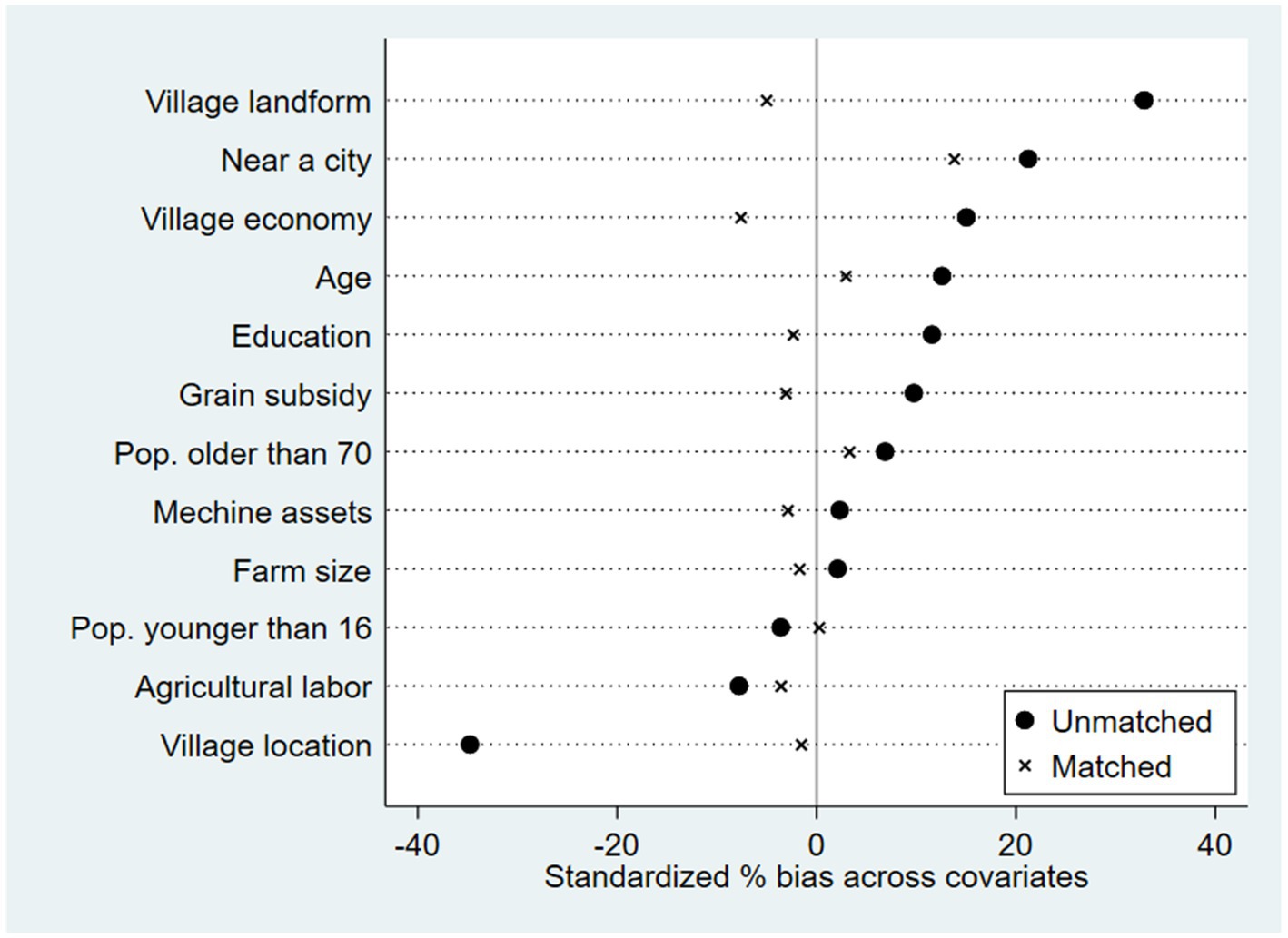- 1School of International Education, Wuhan Business University, Wuhan, China
- 2Collage of Economics and Management, Hubei University of Technology, Wuhan, China
- 3Research Center of Hubei Rural Social Management Innovation, Wuhan, China
- 4Hontye Intelligence Land Technology Consulting Company Limited, Wuhan, China
Introduction: Agricultural services have a substitution effect on agricultural labor. But few studies have considered the impact of agricultural services on grain production from the perspective of heterogeneity in services categories and sources. Therefore, this study examines the impact of agricultural services on grain production in China and explores its heterogeneous effects.
Methods: Utilizing data from the 2018 China Labor-force Dynamics Survey (CLDS2018), this study examines the impact of agricultural services on grain production through the PSM method. Secondly, robustness and endogeneity checks were conducted using IPWRA and IV-probit models, respectively. Finally, heterogeneity analysis was conducted on service categories and sources.
Results: Agricultural services can contribute to grain production; the robustness and endogeneity tests also confirmed this finding. However, there are heterogeneous effects in the service categories and service sources. In detail, machinery service and technical service have positive effect on grain production except agricultural materials supply service. And the positive effect of agricultural services was significant when the supplier of the services is government or voluntary organizations.
Discussion: Based on the above findings, promoting the development of service markets and establishing a favorable market environment will enhance the positive impact of agricultural services on grain production, thereby contributing to ensure food security in developing countries with millions of small households.
1 Introduction
Food security is an important goal in achieving the United Nations 2030 Sustainable Development Goals. According to the latest issue of the State of Food Security and Nutrition in the World report, countries need to make great efforts and take immediate action to promote the transformation of the agricultural food system to realize the commitment to eradicate hunger by 2030. The safety and sustainable development of food supply all over the world has always been a concern (Lambin and Meyfroidt, 2010). Since Brown (1995) published Who Will Feed China? China’s grain security has become a worldwide concern.
Grain production is a key link to ensure grain security. In 2024, China’s total grain output reached 706.499 million tons, an increase of 1.6% over the previous year. It exceeded 700 million tons for the first time, on the basis of nine consecutive years of stabilization above 650 million tons.
There are numerous factors that affect the grain production, and the exiting studies focus on macro or micro level. At the macro level, the existing literatures focused on the impact of climate change (Li et al., 2020; Ha et al., 2021; Feng et al., 2025), economic development (Wang et al., 2025), urbanization (Shen et al., 2024), land use change (Liu et al., 2015; Lu et al., 2024; Zhou and Fu, 2025), and policy (Wang et al., 2007; Lu et al., 2013; Yi et al., 2015; Fan et al., 2023) on grain production. At the micro level, the existing literatures focused on the impact of off-farm employment, land transfer and grain subsidy on rural household’s grain production. Research has indicated that off-farm employment has been a dominant effect of farm exit (Zhan et al., 2012), thus it can constrain the grain production (McCarthy et al., 2009; De Brauw, 2010). However, some literatures had demonstrated that off-farm employment did not significantly affect the grain production (Wu and Meng, 1996). Because off-farm employment loosens the household budget constrain by remittances, which allows households to improve their agricultural productivity (Rozelle et al., 1999). In addition, Yang et al. (2020) found the effect of off-farm employment on grain production was non-liner, and it had an inverted-U relationship. At the same time, due to high land rents, farmers prefer planting crops and reducing grain production (Zhao et al., 2017). Therefore, land transfer negatively affects grain production (Chen et al., 2014; Otsuka et al., 2016). In contrast, several studies have shown that land renting-in has positive effect on grain production (Liu et al., 2018), especially when there is less labor available for agriculture (Qiu et al., 2020).
In recent years, against the background of massive migration of agricultural labor and rising labor costs, agricultural services have a substitution effect on agricultural labor and alleviate agricultural labor constraints. Hence, another line of research has focused on the impact of agricultural services on grain production recently in China. Agricultural services have a positive impact on grain production area, and contribute to enhancing the production efficiency (Li et al., 2024; Qiao, 2020; Xu et al., 2025). In other parts of Asia and Africa, agricultural services also have a significant impact on food production. In rural areas of Southeast Asia, agricultural services are widely utilized in grain production (Justice and Biggs, 2020; Belton et al., 2021). Agricultural machinery services significantly contribute to food security and farm incomes in Bangladesh (Mottaleb et al., 2017). And agricultural services play an important role in raising farm incomes in South Africa (Baiyegunhi et al., 2019).
A review of the relevant literature reveals that most studies focus on the economic impacts of agricultural services, such as their effects on production efficiency and farmer income, while fewer literatures explore the influence of agricultural services on farmers’ crop structure. Secondly, much of the literature emphasizes the impact of agricultural machinery services on agricultural production (Mottaleb et al., 2017; Qing et al., 2019; Chaya et al., 2019; Qiu et al., 2021a,b,c). However agricultural services represent a comprehensive services system encompassing various agricultural production processes, Tang et al. (2018) clarified agricultural services into three phases and five categories: pre-production (agricultural materials supply services), medium-production (including financial services, technical services and machinery services) and post-production (processing and sales services). Furthermore, agricultural services also involve different service suppliers, such as agricultural enterprises, government services, agricultural universities, rural cooperatives, and agricultural specialists. In this study, agricultural services involve farmers delegating some or all of the agricultural production process to service suppliers, who then provide services to farmers on a fee-for-service basis. Due to data limitations, this article only focuses on three service categories (machinery services, technical services, and agricultural materials supply services) and three services sources (government, voluntary organizations, and agricultural enterprises). Except for Li et al. (2024) and Qiu et al. (2021c), fewer studies have examined the impact of service categories heterogeneity. However, these literatures primarily focus on the heterogeneity of medium-production services (such as plowing, sowing, medicating, fertilizing, irrigation, harvesting services). The heterogeneous effects of agricultural services on crop structures from the perspectives of service categories and service sources is under-analyzed.
To fill the literature gap, in this study, we investigated two main research questions through empirical analysis: (1) Do agricultural services promote or inhibit the production of grain crops? (2) Can it be applied equally among the different service categories and the different service sources?
The answers to the above questions have important theoretical value and practical significance. The results of this research could serve to develop the agricultural services market, promote the grain production, and ensure China’s longer-term food security. Our study also has important implications for developing countries with similar characteristics in agriculture to China.
2 Background and theoretical framework
2.1 Background: grain crops vs. cash crops
To explore farmers’ crop choice decisions, it is necessary to analyze the characteristics of factor requirement for grain crops and cash crops. As shown in Table 1.
Firstly, the two crops have different requirements for labor. Rural China’s agricultural production still heavily relies on labor input (Kung, 2002). According to the National Agricultural Product Cost and Income Data Compilation, the average acreage of labor used was 4.44 for the three grain crops (rice, wheat, and maize) and 2.37 for soybeans. And the average acreage of labor used for peanuts, rapeseed and cotton was 7.62, 6.11 and 10.94, respectively. At the same time, there is a clear seasonality of labor inputs in food production. On the contrary, most cash crops have a relatively even demand for labor at different times of the year. This shows that cash crops have a much higher degree of labor demand than grain crops and are labor intensive.
Secondly, the two crops have different requirements of technology. Cash crops have a higher level of demand for technology and, conversely, grain crops have a lower level of demand for technology. As a result, grain crops are better suited to specialization.
Thirdly, there are differences in the difficulty of mechanical operations between the two crops. According to the data from China Agricultural Machinery Industry Yearbook, in 2023, the comprehensive mechanization rates of wheat, rice, and corn were 97.81, 88.03, and 91.67%, respectively. Conversely, the rates of rapeseed, potatoes, and peanuts were 67.80, 56.89, and 68.25%, respectively. That is to say, compares to cash crops, grains crops have lower difficulty in adopting mechanized operations.
As mentioned above, grain crops have lower requirements for labor and technology, and the difficulty of mechanical operations is relatively low. Due to the substitution effect of agricultural services on labor and technology, farmers who grow grain crops are more likely to adopt agricultural services. Cash crops, on the other hand, are characterized by high labor and high technology requirements, so farmers rarely adopt agricultural services in the production of cash crops.
2.2 Theoretical framework
In the context of the massive migrant of rural labors, labor cost is one of the major factors driving up the agricultural production cost in China (Luo, 2018). As a result, agricultural services are widely emerging in rural China. According to the China Rural Policy and Reform Statistics Annual Report 2020, the total number of agricultural service organizations was 955 thousand, an increase of 6.9% over the previous year, with a total service operating income of 166.36 billion yuan.
In the actual production process, as the basic unit of agricultural operation, farmers often analyze the feasibility and convenience of grain production according to the maximization of income and their own resource endowment. Cash crops offer high profit margins but require high-tech planting techniques, the lengthy growth cycle and a significant number of manual labor inputs at the early stages of production, which result in higher capital and time costs when purchasing agricultural services. In contrast, grain crops have relatively low labor and technology requirements, and agricultural machinery has a stronger substitution effect on labor (Zhang et al., 2023). That is to say, the current grain cultivation has a more mature and perfect production technology and operational processes that facilitate large-scale batch operation of machinery (Zhou et al., 2023). This is conducive to the services suppliers undertaking a wider range of grain growers in the production service business. Overall, as the market for agricultural services improves, grain crops can reduce the cost of production services through more concentrated labor hours and more labor substitution. Therefore, farmers who have a demand for agricultural services tend to choose grain crops with lower costs and risks and are more adaptable to the characteristics of service supply in order to realize their expected returns (Li et al., 2024). Based on the above inference, the following hypothesis is put forward in this study:
H1. Agricultural services promote the farmers’ grain production.
With the development of agricultural services market, the agricultural services had appeared throughout the whole process of grain production (Tang et al., 2018). In the pre-production phase, it mainly includes agricultural materials supply service. In the medium-production phase, it mainly includes financial service, technical service (including irrigation, disease and pest control, and technical training), and machinery service (including ploughing, seeding, transplanting, and harvesting). And in the post-production phase, it mainly includes processing and sales service. There are also differences in the contribution of agricultural services to grain production for different service categories. Hence, this study put forward the following hypothesis:
H2. The positive effect of agricultural services on grain production is heterogeneous across service categories.
Agricultural services have different suppliers for different categories of agricultural services. The government is the primary supplier of agricultural services, mainly providing public agricultural services. The agricultural materials companies, agricultural machinery companies, agricultural enterprises and rural credit cooperatives mainly provide commercial agricultural services. While farmer cooperatives, research institutes and agricultural technology service stations are organizations with dual quality of public and private interests, providing semi-public agricultural services.
Due to the characteristic of agricultural services, there are differences in the agricultural services provided by different supplier, which in turn lead to differences in the impact effects on grain production. Therefore, the following hypothesis was formulated:
H3. The positive effect of agricultural services on grain production is heterogeneous across service sources.
The conceptual framework of this stated relationship is shown in Figure 1.
3 Methodology
3.1 Data
This study draws data from the 2018 China Labor-Force Dynamics Survey (CLDS2018). The survey was conducted by the Centre for Social Science Survey at Sun Yat-Sen University, China. The CLDS dataset involves relatively rich information about households in China, including the basic structure of the family, economic condition, agricultural production, land use and other aspects. It has been recognized as one of the most nationally representative surveys in China. This paper focuses on studying the impact of the agricultural services on grain production. Furthermore, considering that there are numerous factors affecting the grain production, we also retained relevant variables such as individual characteristics, household characteristics and village characteristics. However, considering that not every household provided all the information on the above variables, we deleted the samples of farm households who did not participate in agricultural production, and we deleted the missing values of key variables, such as the agricultural services, farm size, and so on. In the end, we got a cross-sectional data of 4,011 farm households covering 214 villages in 26 provinces across the country.
3.2 Variables and descriptive statistics
3.2.1 Dependent variable
Grain production. Following the previous literatures, we defined grain production as dummy variable (Yi and Chen, 2010; Luo et al., 2018). Specifically, the grain production variable takes the value of 1 if household planted the grain crops and 0 otherwise.
3.2.2 Independent variable
Agricultural services. According to Huan et al. (2022), the agricultural services is a binary indicator, where the value of 1 signifies that the household adopted the agricultural services, and 0 otherwise.
3.2.3 Control variables
According to the existing studies, our paper mainly controls for individual, household, and village characteristics, which are deemed to influence both agricultural services and grain production (Wu and Meng, 1996; Qiu et al., 2020; Yang et al., 2020; Fan et al., 2023). The detailed definitions of the variables are presented in Table 2.
3.2.4 Descriptive statistics
Table 2 also shows the descriptive statistics stratified by the farms whether to adopted agricultural services. T-tests and chi-square tests are applied to assess whether difference between the farms who adopted agricultural services group and farms who did not adopt agricultural services group are statistically significant. On average, the 68% of farm households adopted the agricultural services. And our final samples consist of 2,750 farm households that adopted agricultural services and 1,261 farm households that did not adopt agricultural services. In addition, we also found that grain production, age, education, agricultural labor, Pop. older than 70, grain subsidy, village economy, village landform, village location, and near a city were significantly different between the two groups.
3.3 Estimation strategy
In order to accurately estimate the effect of agricultural services on the farmers’ grain production. Let be the grain production of farmer if the farmer adopted the agricultural services (“treated”), and the grain production of the same farmer if the farmer did not adopt the agricultural services (“control”). According to Rosenbaum and Rubin (1983), the treatment effect of adopting agricultural services can be simply defined as:
In estimating Equation 1, a problem arises because we can observe either or , but not both of them for each individual farmer at the same time. This is a classical impact evaluation problem, which is also known as a missing data (counterfactual) problem.
Propensity score matching (PSM) was developed to address this missing data problem. In our case, having data from both farmers who adopted agricultural services () and farmers who did not adopt agricultural services () allows one to compute , which can be easily decomposed into and by adding and subtracting a same term, . The details see the Equation 2.
The term is the average treatment effect on the treated (ATT), which is what we want. The other term, , is the selection bias. Except for the case where the farmers who adopted agricultural services and the farmers who did not adopt agricultural services are assigned randomly, the selection bias is unlikely to be zero. The PSM method is developed to minimize the selection bias.
The basic idea of PSM method is to find a large group of farmers that did not adopt the agricultural services who are similar to the farmers that adopted the agricultural services in all relevant pre-treatment characteristics. And then match farmers who adopted agricultural services to farmers who did not adopt according to the propensity scores. In the present study, we adopted the kernel-based matching to calculate the ATT. And we used the IPWRA and IV-probit methods for robustness and endogeneity checks. In addition, the reliability of the matching estimates is largely dependent on the quality of matching. Both criteria will be checking in this paper.
4 Results
4.1 Logit model on determinants of farmers’ agricultural services adoption
The determinants of farmers’ agricultural services adoption are estimated with a logit model to obtain the propensity scores used for matching. However, the multicollinearity problem makes it difficult to accurately estimate the model, especially in cross-sectional data. Hence, before the logit model, we test the variance inflation factor (VIF) of each explanatory variable. All the VIFs are less than 10, suggesting that the estimated model is free of any serious multicollinearity.
The logit model and marginal effect results are reported in Table 3. On the individual level, the age and education of the householder were positively related to farmers’ agricultural services adoption at the 1% level. And for each unit increase in education and age, the probability of farmers adopting agricultural services increased by 0.3 and 0.7%, respectively.
In terms of household characteristics, agricultural labor had negative effect on the farmers’ agricultural services adoption at the 1% level. And the probability of the agricultural services adoption decreased by 10% for each unit increased in agricultural labor. Grain subsidy had positive effect on the farmers’ agricultural services adoption at the 10% level. In other words, compared to household who do not receive grain subsidies, household who receive grain subsidies have a 2.7 percentage point higher probability of adopting agricultural services.
Regarding the village characteristics, the village economy, village landform and near a city had positive effects on adoption of agricultural services at the 1% level. For each unit increase in village economy, the probability of farmers adopting agricultural services increased by 0.2%. Farmers in the plain were 11.1% more likely to adopt agricultural services than farmers in non-plain areas. And farmers in suburban areas of large and medium-sized cities were 22.5% more likely to adopt agricultural services than farmers in non-suburban areas. Moreover, the village location had negative effect on the farmers’ agricultural services adoption at the 1% level. And the probability of the agricultural services adoption decreased by 1.1% for each unit increased in the distance from the village to the nearest town.
4.2 Matching quality
Before we present the matching estimates on the effect of agricultural services on grain production, it is important to check the quality of the kernel-based matching.
Firstly, the distribution of predicted propensity scores shows a large common support of propensity scores between the farmers adopted agricultural services and farmers did not adopt agricultural services. As a result, only 22 observations off support in control group and 6 observations off support in treatment group, and all the 28 observations not in the common support region were excluded from the analysis (the details see the Table 4). Table 4 shows a significant overlap between the two distributions with very few off-support observations, confirming high common support. This means that the common support assumption is satisfied.
Secondly, the pseudo-R2 and the mean bias were lower after matching than before. Before matching, the pseudo-R2 and the mean bias were 0.054 and 13.4, respectively. But they were reduced after matching (0.005 and 4.0, respectively).
Finally, the PSM quality indicators before and after matching are reported in Table 5. Except for the machine assets variable, the bias of all variables after matching decreased substantially. In addition, the variables including age, education, agricultural labor, Pop. older than 70, grain subsidy, and village location were significantly different at the 1% between the control group and treatment group before the matching, and all of them were insignificant after matching. Meanwhile, according to the Figure A1, the distribution of standardized deviations of each variable before matching was relatively discrete. However, after applying the kernel-based matching method, the standardized deviations of each variable were less than 10%, and most of them were near the 0 value, which shows a significant reduction compared with the pre-matching period.
Furthermore, Figure 2 illustrates the kernel density functions of the treatment group and the control group based on pre- and post-matching of the two groups, respectively. The kernel density functions of the two groups were significantly different before matching. After matching, the kernel density functions of the two groups were a lot closer, indicating that the characteristics of the variables were similar in the two groups after matching. This means that there was no systematic difference between the treatment and control groups after matching, thus satisfying the balance test.
The overall evidence suggests that the matching process successfully achieved covariate balance by eliminating potential bias between the treatment groups and control groups arising from observed variables. Next, we estimate the treatment effect of agricultural services on grain production.
4.3 Overall effect across propensity scores
The kernel-based matching method was used to estimate the effect of agricultural services on grain production (see Table 6). The analysis based on the entire sample shows that agricultural services significantly increased farmers’ likelihood to plant grain crops in all respects. Specifically, agricultural services will contribute to increasing the probability of planting grain crops by about 4.8%. This indicates that agricultural services can contribute to grain production. Thus, the H1 was supported.
4.4 Robustness and endogeneity checks
4.4.1 Robustness check
Robustness check is conducted by modifying the model specification. Drawing on existing studies (Ma et al., 2024; Cao et al., 2024), the PSM might omit certain samples, and it relies heavily on the assumption that the treatment model specification is appropriately specified and overlooks the correct specification of the outcome model. According to Wooldridge (2003), IPWRA estimates would be consistent even if the treatment or outcome were not specified correctly. Therefore, we employ the IPWRA estimator to check the robustness of the estimates obtained from the PSM, considering that it has a double-robust property that relaxes the strong assumption of the PSM model.
The IPWRA results estimating the treatment effects of agricultural services on grain production are presented in Table 7. The potential-outcomes means (POMS) for farmers who adopted agricultural services and those who did not were 0.881 and 0.825, respectively, both of which were significant at the 1% level. The average treatment effect (ATE) of agricultural services on grain production was 0.056. Thus, households that adopted agricultural services had grain production of 5.6% higher than non-agricultural services. These results were consistent with the findings shown in Table 6, thereby reinforcing the robustness of our conclusions.
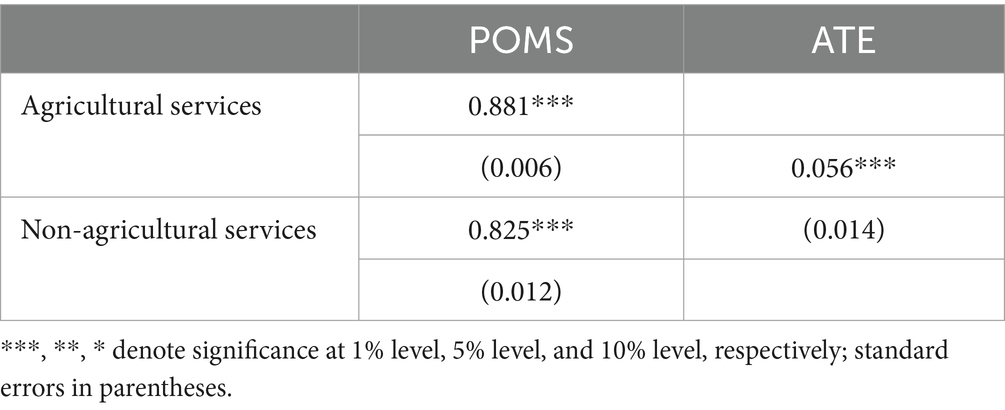
Table 7. Impact of agricultural services on grain production: robustness check from the IPWRA estimates.
4.4.2 Endogeneity check
To address potential endogeneity concerns, we also used the IV-probit model to examine the effect of agricultural services on grain production. The instrumental variable must be strongly correlated with the adoption of agricultural services but must not directly influence the household’s grain production. Consequently, the average number of agricultural services adopted by other farmers in the village was selected as the instrumental variable. A household’s decision to adopt the agricultural services is likely to be affected by the agricultural services adopt status of their neighbors. But the mimicry on agricultural services is less likely to directly influence the household’s decision to plant cash crops or grain crops. As shown in Table 8, the first stage F-statistic was 456.08, well above the critical value of 10, thereby rejecting the hypothesis of weak instruments and confirming that selected instrumental variable effectively addressed endogeneity concerns. Additionally, the IV-Probit model successfully passed the Wald test, indicating that the instrumental variable was valid and the parameter estimates were reliable. The second-stage results showed that the coefficient for the effect of agricultural services on grain production was 0.322 (significant at the 1% level). This finding supported the argument that agricultural services contribute to grain production, thereby confirming the robustness of the study’s conclusions.
4.5 Heterogeneity analysis
4.5.1 Heterogenous effects across the service categories
The definition of agricultural services in Table 2 was whether to adopt agricultural services. This definition may omit some important information about the different services contents. According to Tang et al. (2018), we clarified agricultural services into three categories: machinery services, technical services, and agricultural materials supply services. Specifically, the contents of machinery services include machinery ploughing, sowing, and harvesting. The contents of technical services include irrigation, disease, and pest control. And the contents of agricultural materials supply services include supply of seeds (seedlings), chemical fertilizers, pesticides, and agricultural films. Consequently, following the PSM model, we re-estimate the impact of agricultural services on grain production by separating the machinery, technical, and agricultural materials supply services. The results are presented in Table 9.
After matching, machinery services and technical services were statistically significant at the 1% level and had a positive impact on grain crops plantation. The contribution effect of machinery services to grain production was 6.1%. The contribution effect of technical services to grain production was 4.4%, slightly smaller than the contribution effect of machinery services. However, agricultural materials supply services had not a significantly impact on grain production. Thus, the H2 was supported. Furthermore, we applied IPWRA to examine the heterogenous effects across the services categories (see Table A1). The estimation results of IPWRA showed that agricultural machinery services had the greatest promoting effect on grain production, followed by technical services, and the agricultural materials supply services was not significant. These results were consistent with the findings shown in Table 9, thereby reinforcing the robustness of our conclusions.
4.5.2 Heterogenous effects across the service sources
Regarding the sources of agricultural services, we clarified the supplier of agricultural services into three categories: government, voluntary organizations (including research institutions, higher education institutions and so on), and agricultural enterprises. Following the PSM model, we re-estimate the impact of agricultural services on grain production by separating the contributions of government, voluntary organizations, and agricultural enterprises. The results are presented in Table 10.
When the primary supplier of agricultural services was government, the positive effect of agricultural services on grain production was 0.041. Meanwhile, the effect of agricultural services on grain production was 0.068 when the primary supplier of agricultural services was voluntary organizations. And there are statistically significant at the 1 and 5% level, respectively. However, when the primary supplier was agricultural enterprises, the effect of agricultural services was insignificant. The reasons why it was not significant are: agricultural services market suffer from the market failures. More specifically, some agricultural services in the market have the attributes of public goods. And the agricultural services provided by agricultural enterprises do not cover all the phases of agricultural production (including pre-production, medium-production, and post-production). It thus has a limited effect on grain production. Thus, the H3 was supported. Combining the three primary suppliers mentioned above, agricultural services provided by voluntary organizations had the greatest positive effect on grain production, following by the government, and the impact effect generated by agricultural enterprises was not significant. Similarly, we applied IPWRA to examine the heterogenous effects across the services sources (see Table A1). These findings were consistent with the results shown in Table 10, thereby confirming the robustness of the study’s conclusions.
5 Conclusion and policy implications
This study applied the PSM method to examine the effect of agricultural services on grain production. The empirical results proved that agricultural services have positive effect on grain production. Robustness test and endogeneity check also confirmed this finding. Furthermore, this study presented the heterogenous analysis of the positive effect of agricultural services based on the service categories and service sources. The results clearly indicated that machinery service and technical service have positive effect on grain production except agricultural materials supply service. The positive effect of agricultural services was significant when the supplier of the services is government or voluntary organizations.
Several policy implications emerge from this study. First, to ensure food security, policymakers could focus on the agricultural services’ positive effect on the grain production. Municipalities should facilitate the growth of the agricultural services market and make timely adjustments to the cultivation structure in order to ensure food security via policy mechanisms. Policies to maximize the favorable effects of the agricultural service market on grain cultivation. Concurrently, prioritize the farmers in agricultural services guidance and publicity, ensure that they are the primary force behind all types of new agricultural management, and fortify their favorable attitude toward agricultural services. Second, consider the positive impact of agricultural services on grain production, it is imperative that policymakers establish a favorable market environment for the majority of agricultural services. Optimize pertinent policies and regulations, augment production subsidies for diverse service organizations, enhance and compensate for the deficiencies of each service provision link. Encourage diverse service organizations to provide an agricultural service model with a wider range of services and more comprehensive coverage. Additionally, strengthening market oversight is crucial to prevent opportunistic behavior and ensure continuous improvements in service quality and effectiveness.
This study has important implications for China’s food security. The findings of this study can deepen the understanding of relationship between agricultural services and grain production. Agricultural services contribute to grain production, which is an important path for the developing countries to accelerate the realization of agricultural modernization and improve agricultural production efficiency, and also has a positive impact on the China’s food security. Secondly, the results of this study also have implications for other developing countries, especially those with millions of small households. Based on this study, developing countries with millions of small households, such as India and some African countries, might need to encourage the development of agricultural services, and thereby promote grain production and ensure national food security. Meanwhile, the heterogeneous effects of agricultural services on food production indicate that developing countries should, based on their own resource endowments and industrial structures, actively develop diverse agricultural services and cultivate a multi-principal service supplier.
However, several aspects warrant further improvement. Firstly, this study is based on cross-sectional data from 2018, whereas smallholder farmers’ participation in agricultural services is dynamic. Future research should incorporate long-term tracking of smallholder farmers and consider various factors such as policy changes and technological advancements to yield more scientific, rigorous, dan accurate results. Secondly, agricultural services encompass a wide range of services across pre-production, medium-production, and post-production stages. Due to the data limitations, this study primarily focuses on the impact of pre-production and medium-production services on grain production, it does not address the effect of post-production services.
Data availability statement
The original contributions presented in the study are included in the article/supplementary material, further inquiries can be directed to the corresponding author.
Author contributions
WZ: Conceptualization, Data curation, Formal analysis, Methodology, Resources, Software, Validation, Writing – original draft, Writing – review & editing, Visualization. XS: Conceptualization, Funding acquisition, Supervision, Writing – original draft, Writing – review & editing. ZQ: Methodology, Software, Visualization, Writing – review & editing.
Funding
The author(s) declare that financial support was received for the research and/or publication of this article. This research was supported by the National Natural Science Foundation of China (71904150), and the Hubei University of Technology Doctoral Research Initiation Foundation (XJ2024004702).
Conflict of interest
ZQ was employed by the Hontye Intelligence Land Technology Consulting Company Limited.
The remaining authors declare that the research was conducted in the absence of any commercial or financial relationships that could be construed as a potential conflict of interest.
Generative AI statement
The authors declare that no Gen AI was used in the creation of this manuscript.
Any alternative text (alt text) provided alongside figures in this article has been generated by Frontiers with the support of artificial intelligence and reasonable efforts have been made to ensure accuracy, including review by the authors wherever possible. If you identify any issues, please contact us.
Publisher’s note
All claims expressed in this article are solely those of the authors and do not necessarily represent those of their affiliated organizations, or those of the publisher, the editors and the reviewers. Any product that may be evaluated in this article, or claim that may be made by its manufacturer, is not guaranteed or endorsed by the publisher.
References
Baiyegunhi, L. J. S., Majokweni, Z. P., and Ferrer, S. R. D. (2019). Impact of outsourced agricultural extension program on smallholder farmers’ net farm income in Msinga, KwaZulu-Natal, South Africa. Technol. Soc. 57, 1–7. doi: 10.1016/j.techsoc.2018.11.003
Belton, B., Win, M. T., Zhang, X., and Filipski, M. (2021). The rapid rise of agricultural mechanization in Myanmar. Food Policy 101:102095. doi: 10.1016/j.foodpol.2021.102095
Brown, L. R. (1995). Who will feed China? Wake-up call for a small planet. New York: W.W. Norton & Company.
Cao, A., Su, M., and Li, H. (2024). Digitizing the green revolution: E-commerce as a catalyst for clean energy transition in rural China. Energy Econ. 137:107778. doi: 10.1016/j.eneco.2024.107778
Chaya, W., Bunnag, B., and Gheewala, S. H. (2019). Adoption, cost and livelihood impact of machinery services used in small-scale sugarcane production in Thailand. Sugar Tech 21, 543–556. doi: 10.1007/s12355-018-0651-x
Chen, R., Ye, C., Cai, Y., Xing, X., and Chen, Q. (2014). The impact of rural out-migration on land use transition in China: past, present and trend. Land Use Policy 40, 101–110. doi: 10.1016/j.landusepol.2013.10.003
De Brauw, A. (2010). Seasonal migration and agricultural production in Vietnam. J. Dev. Stud. 46, 114–139. doi: 10.1080/00220380903197986
Fan, P., Mishra, A. K., Feng, S., Su, M., and Hirsch, S. (2023). The impact of China’s new agricultural subsidy policy on grain crop acreage. Food Policy 118:102472. doi: 10.1016/j.foodpol.2023.102472
Feng, X., Liu, D., Zhao, J., Si, W., and Fan, S. (2025). Impact of climate change on farmers’ crop production in China: a panel Ricardian analysis. Humanit. Soc. Sci. Commun. 12:250. doi: 10.1057/s41599-024-04287-5
Ha, T. T. V., Fan, H., and Shuang, L. (2021). Climate change impact assessment on Northeast China’s grain production. Environ. Sci. Pollut. Res. 28, 14508–14520. doi: 10.1007/s11356-020-11602-5
Huan, M., Dong, F., and Chi, L. (2022). Mechanization services, factor allocation, and farm efficiency: evidence from China. Rev. Dev. Econ. 26, 1618–1639. doi: 10.1111/rode.12892
Justice, S., and Biggs, S. (2020). The spread of smaller engines and markets in machinery services in rural areas of South Asia. J. Rural. Stud. 73, 10–20. doi: 10.1016/j.jrurstud.2019.11.013
Kung, J. K. (2002). Off-farm labor markets and the emergence of land rental markets in rural China. J. Comp. Econ. 30, 395–414. doi: 10.1006/jcec.2002.1780
Lambin, E. F., and Meyfroidt, P. (2010). Land use transitions: socio-ecological feedback versus socio-economic change. Land Use Policy 27, 108–118. doi: 10.1016/j.landusepol.2009.09.003
Li, R., Chen, J., and Xu, D. (2024). The impact of agricultural socialized service on grain production: evidence from rural China. Agriculture 14:785. doi: 10.3390/agriculture14050785
Li, Y., Li, F., Yang, F., Xie, X., and Yin, L. (2020). Spatiotemporal impacts of climate change on food production: case study of Shaanxi Province. China. Environ. Sci. Pollut. Res. 27, 19826–19835. doi: 10.1007/s11356-020-08447-3
Liu, Y., Wang, C., Tang, Z., and Nan, Z. (2018). Will farmland transfer reduce grain acreage? Evidence from Gansu province. China. China Agric. Econ. Rev. 10, 277–292. doi: 10.1108/CAER-04-2017-0072
Liu, G., Zhang, L., Zhang, Q., and Musyimi, Z. (2015). The response of grain production to changes in quantity and quality of cropland in Yangtze River Delta. China. J. Sci. Food Agric. 95, 480–489. doi: 10.1002/jsfa.6745
Lu, D., Wang, Z., Su, K., Zhou, Y., Li, X., and Lin, A. (2024). Understanding the impact of cultivated land-use changes on China’s grain production potential and policy implications: a perspective of non-agriculturalization, non-grainization, and marginalization. J. Clean. Prod. 436:140647. doi: 10.1016/j.jclepro.2024.140647
Lu, Q., Xu, B., Liang, F., Gao, Z., and Ning, J. (2013). Influences of the grain-for-green project on grain security in southern China. Ecol. Indic. 34, 616–622. doi: 10.1016/j.ecolind.2013.06.026
Luo, B. (2018). 40-year reform of farmland institution in China: target, effort and the future. China Agric. Econ. Rev. 10, 16–35. doi: 10.1108/CAER-10-2017-0179
Luo, B., Jiang, X., Li, S., and Qiu, T. (2018). Does land transfer lead to “non-grain growing” in agricultural planting structure. Jianghai Acad. J. :238.
Ma, W., Zhou, X., Boansi, D., Horlu, G. S. A., and Owusu, V. (2024). Adoption and intensity of agricultural mechanization and their impact on non-farm employment of rural women. World Dev. 173:106434. doi: 10.1016/j.worlddev.2023.106434
McCarthy, N., Carletto, C., Kilic, T., and Davis, B. (2009). Assessing the impact of massive out-migration on Albanian agriculture. Eur. J. Dev. Res. 21, 448–470. doi: 10.1057/ejdr.2009.12
Mottaleb, K. A., Rahut, D. B., Ali, A., Gérard, B., and Erenstein, O. (2017). Enhancing smallholder access to agricultural machinery services: lessons from Bangladesh. J. Dev. Stud. 53, 1502–1517. doi: 10.1080/00220388.2016.1257116
Otsuka, K., Liu, Y., and Yamauchi, F. (2016). The future of small farms in Asia. Dev. Policy Rev. 34, 441–461. doi: 10.1111/dpr.12159
Qiao, F. (2020). The impact of agricultural service on grain production in China. Sustainability 12:6249. doi: 10.3390/su12156249
Qing, Y., Chen, M., Sheng, Y., and Huang, J. (2019). Mechanization services, farm productivity and institutional innovation in China. China Agric. Econ. Rev. 11, 536–554. doi: 10.1108/CAER-12-2018-0244
Qiu, T., Choy, S. T. B., Li, S., He, Q., and Luo, B. (2020). Does land renting-in reduce grain production? Evidence from rural China. Land Use Policy 90:104311. doi: 10.1016/j.landusepol.2019.104311
Qiu, T., Choy, S. T. B., Li, Y., Luo, B., and Li, J. (2021b). Farmers’ exit from land operation in rural China: does the price of agricultural mechanization services matter? China World Econ. 29, 99–122. doi: 10.1111/cwe.12372
Qiu, T., Choy, S. T., and Luo, B. (2021a). Is small beautiful? Links between agricultural mechanization services and the productivity of different-sized farms is small beautiful? Appl. Econ. 54, 430–442. doi: 10.1080/00036846.2021.1963411
Qiu, T., Shi, X., He, Q., and Luo, B. (2021c). The paradox of developing agricultural mechanization services in China: supporting or kicking out smallholder farmers? China Econ. Rev. 69:101680. doi: 10.1016/j.chieco.2021.101680
Rosenbaum, P. R., and Rubin, D. B. (1983). The central role of the propensity score in observational studies for causal effects. Biometrika 70, 41–55. doi: 10.1093/biomet/70.1.41
Rozelle, S., Taylor, J. E., and deBrauw, A. (1999). Migration, remittances, and agricultural productivity in China. Am. Econ. Rev. 89, 287–291. doi: 10.1257/aer.89.2.287
Shen, W., Hu, Q., and Zhang, Z. (2024). Impacts of in situ urbanisation on grain production: evidence from the Yangtze River Delta. China. Habitat Int. 143:102989. doi: 10.1016/j.habitatint.2023.102989
Tang, L., Liu, Q., Yang, W., and Wang, J. (2018). Do agricultural services contribute to cost saving? Evidence from Chinese rice farmers. China Agric. Econ. Rev. 10, 323–337. doi: 10.1108/CAER-06-2016-0082
Wang, R., Deng, X., Gao, Y., and Chen, J. (2025). Does regional economic development drive sustainable grain production growth in China? Evidence from spatiotemporal perspective on low-carbon total factor productivity. Socio Econ. Plan. Sci. 98:102129. doi: 10.1016/j.seps.2024.102129
Wang, X., Lu, C., Fang, J., and Shen, Y. (2007). Implications for development of grain-for-green policy based on cropland suitability evaluation in desertification-affected North China. Land Use Policy 24, 417–424. doi: 10.1016/j.landusepol.2006.05.005
Wooldridge, J. M. (2003). Cluster-sample methods in applied econometrics. Am. Econ. Rev. 93, 133–138. doi: 10.1257/000282803321946930
Wu, H. X., and Meng, X. (1996). The direct impact of the relocation of farm labour on Chinese grain production. China Econ. Rev. 7, 105–122. doi: 10.1016/S1043-951X(96)90003-6
Xu, K., Yi, X., and Zhou, L. (2025). Impacts of agricultural production services on green grain production efficiency: factors allocation perspective. J. Environ. Manag. 380:125136. doi: 10.1016/j.jenvman.2025.125136
Yang, J., Wan, Q., and Bi, W. (2020). Off-farm employment and grain production change: new evidence from China. China Econ. Rev. 63:101519. doi: 10.1016/j.chieco.2020.101519
Yi, X., and Chen, Y. (2010). Analysis of the factors influencing the behavior and scale of farmers’ transfer to farmland and their “non-food” cultivation: based on data from a survey of farmers in Zhejiang and Hebei provinces. China Rural Surv. :2-10+21. (in Chinese). doi: 10.20074/j.cnki.11-3586/f.2010.06.001
Yi, X., Sun, D., and Zhou, Y. (2015). Grain subsidy, liquidity constraints and food security—Impact of the grain subsidy program on the grain-sown areas in China. Food Policy, 50:114–124. doi: 10.1016/j.foodpol.2014.10.009
Zhan, J., Wu, Y., Zhang, X., and Zhou, Z. (2012). Why do farmers quit from grain production in China? Causes and implications. China Agric. Econ. Rev. 4, 342–362. doi: 10.1108/17561371211263365
Zhang, Y., Zhang, J., Liu, Y., and Zhu, P. (2023). Agricultural machinery service adoption and farmland transfer-in decision: evidence from rural China. Front. Environ. Sci. 11:1195877. doi: 10.3389/fenvs.2023.1195877
Zhao, X., Zheng, Y., Huang, X., Kwan, M., and Zhao, Y. (2017). The effect of urbanization and farmland transfer on the spatial patterns of non-grain farmland in China. Sustainability 9:1438. doi: 10.3390/su9081438
Zhou, J., and Fu, M. (2025). Degree of non-grain production of cultivated land and its impact on grain production in China: analysis of 2481 county-level units. Land Use Policy 155:107586. doi: 10.1016/j.landusepol.2025.107586
Zhou, Z., Zhang, K., Wu, H., Liu, C., and Yu, Z. (2023). Land transfer or trusteeship: can agricultural production socialization services promote grain scale management? Land 12:797. doi: 10.3390/land12040797
Appendix
Keywords: food security, agricultural services, grain production, service categories, service sources
Citation: Zhu W, Sun X and Qi Z (2025) Do agricultural services contribute to grain production? The heterogeneity analysis based on service categories and service sources. Front. Sustain. Food Syst. 9:1633290. doi: 10.3389/fsufs.2025.1633290
Edited by:
Muhammad Asad Ur Rehman Naseer, Bahauddin Zakariya University, PakistanReviewed by:
Xuetao Sun, Ocean University of China, ChinaGuanqiu Yin, Shenyang Agricultural University, China
Copyright © 2025 Zhu, Sun and Qi. This is an open-access article distributed under the terms of the Creative Commons Attribution License (CC BY). The use, distribution or reproduction in other forums is permitted, provided the original author(s) and the copyright owner(s) are credited and that the original publication in this journal is cited, in accordance with accepted academic practice. No use, distribution or reproduction is permitted which does not comply with these terms.
*Correspondence: Xiaoyu Sun, MjAyNDEwOTdAaGJ1dC5lZHUuY24=
 Weijing Zhu
Weijing Zhu Xiaoyu Sun
Xiaoyu Sun Zhenhui Qi4
Zhenhui Qi4

